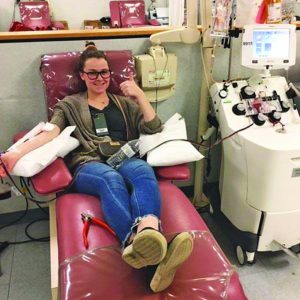
After studying abroad in Florence, Italy during her junior year of college at the University of South Carolina, Madalyn Connors, a resident of Port Washington, was forced to leave Europe and come home after the coronavirus pandemic began to strike.
On March 11, two days after arriving home, Connors started exhibiting symptoms of coronavirus. After experiencing a severe headache, a slight cough, a fever and body aches, Connors called her primary care physician and explained that she had been to Europe and now was experiencing symptoms. In order to get tested for the virus, Northwell Health had to get approval from the Department of Health and inform the Center of Disease Control and Prevention (CDC) about Connors symptoms. A few hours later, Connors was able to schedule an appointment at the Northwell Health Urgent Care center in Port Washington where she was tested for the virus that same day.
Fortunately, four days after feeling sick and testing positive, the 21-year-old was feeling nearly 100 percent better.
“I was very lucky and recovered super quickly,” Connors said. “It’s crazy to see how some people are really struggling to fight the virus. Had I not been in Europe the week before, I probably wouldn’t have gone to the doctor. The only thing that was really bothering me was a headache, and I sometimes get those. But this one was obviously very different it was way more severe.”
On April 6, Connors became the first person on Long Island to donate convalescent plasma, a treatment being used to help patients who are suffering from coronavirus potentially fight off the illness quicker.
“Convalescent plasma is plasma, the liquid part of the blood, that comes from patients who have recently recovered from COVID-19 disease and in that plasma are antibodies which give an immune response that the person uses to fight the virus,” Bruce Sachais, chief medical officer at the New York Blood Center (NYBC), said. “The idea is to take those antibodies and give them to someone who is currently fighting the disease and that will hopefully help their immune system to start fighting the infection while the body makes its own antibodies.”
After seeing a notification on Facebook asking people who had recovered from coronavirus to get tested for antibodies, Connors decided to fill out a form to see if she was eligible to donate.
“I had just wanted to see if I had antibodies or if I still had the virus in my system,” she said. “I went to Mount Sinai and got the test done. They called me two days later and said the virus was negative so it wasn’t present in my system at all anymore and that my antibody levels were very high. At that point it wasn’t even a thought in my mind, I figured if I had these antibodies and I was so lucky that I was barely sick, I may as well just do whatever I can to help the people that need it.”
As a first time donor, Connors described the donation process as a quick, easy and painless process. During a plasma donation, an apheresis machine separates the parts of the blood, collecting only the plasma and returning everything else back to the donor.
By donating only plasma, the blood center is able to take a larger volume of plasma than they would normally be able to with a standard blood donation. One plasma donation can help up to three patients suffering from COVID-19.
Although modern medicine has advanced tremendously in the past 100 years, this is not the first time convalescent plasma has been used to help people recover from illnesses. The collection of convalescent plasma was used during the Spanish Flu epidemic of 1918, and more recently, to fight the SARS epidemic and MERS.
“There have been other coronaviruses that this has been tried for and there was some success reported for those,” Sachais said. “From the literature we have, which is limited since this is a relatively new infection, it does appear that most patients who have recovered from COVID have significant antibodies in their plasma. I’m cautiously optimistic based on the information that has been published from several case series out of China as well as some descriptions of use in the city that this will be helpful for some of the COVID patients.”
The Food and Drug Administration (FDA) allows two donations within a seven-day period, with at least 48 hours between donations. On April 13, one week after her first donation, Connors went back to the New York Blood Center to donate more plasma.
“The whole reason I shared my story was because I know a lot of people that had COVID-19 didn’t even know about the antibody test and the plasma donations were available,” Connors said. “I wanted more people to know about it. There are so many people that could use the help, and there are so many people that were willing to help but just didn’t know about it. I think if anyone is willing to donate that they 100 percent should. It was painless, it was so easy and it is so important. All of the doctors have been so grateful for it. I could see how donating blood can be intimidating to people, but if you were lucky enough to recover, there is no reason to not help the people that need it the most.”
Patients who have fully recovered from coronavirus and want to find out if they are eligible to donate plasma can visit www.ccpp19.org/donors/donate.html.


































